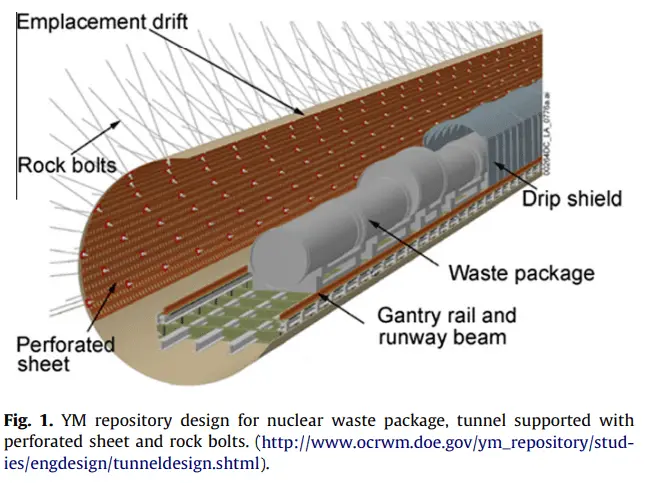Abstract
Rock bolts used for the reinforcement of underground mines, tunnels, and nuclear waste repositories are made up of low and medium-carbon steels, and high-strength low alloy steels. Typical rock bolt systems used for rock reinforcement are mechanically anchored bolts, grout anchored, frictional rock stabilizers and strand anchors. For nuclear waste repository sites such as Yucca Mountain (YM) as well as for mines and tunnels, in addition to mechanical properties, corrosion properties are also important due to potential seepage of water through the fractures or pores in the rock.
During temporary rock support period of 50–100 years, the temperature of the tunnel at YM should be maintained at ambient conditions. For any reason if the rock bolts are exposed to YM waters and high temperatures in the tunnel then there is a chance of corrosion of steel rock bolts. In this study an attempt was made to study the corrosion properties of various potential rock bolts for YM tunnel support via the aid of electrochemical corrosion testing. At ambient temperature (25 C) all the rock bolts that were studied showed good corrosion resistance in these waters.
At higher temperatures, 60 C and 90 C, corrosion resistance of rock bolts decreased, but due to special stress relief heat treatment of one of the frictional rock stabilizers (Swellex Mn 24) the corrosion rates were lower than all other tested rock bolts. Note: Swellex, Split set and Williams are the proprietary names of Atlas Copco, International Roll Forms, Inc. and Williams Form Engineering Corp, respectively.
Introduction
Yucca Mountain (YM) is being considered as repository site for permanent disposal of up to 70,000 metric tons of high-level radioactive waste. The underground excavations are supported with rock reinforcement such as rock bolts and I-beams. The Yucca Mountain Nuclear Waste Repository emplacement drift design is shown in Fig. 1 (http://www.ocrwm.doe.gov/ym_repository/studies/engdesign/tunneldesign.shtml). Development of internal rock support systems began in the early 20th century. In 1936, the St. Joseph lead mine in Missouri first used split wedge rock bolts for mine roof reinforcement (USBM, 1987) and in mid 1940s the expansion anchor bolt was developed.
In 1960, resin based grout rock bolts were used for underground rock reinforcement and by mid 1970s the frictional rock stabilizers, deformable steel tubes had been used for rock support. Now, around the world, different types of rock bolts such as mechanically anchored, grout anchored, frictional stabilizer anchors, strand anchors and other secondary rock accessories are used for rock reinforcement in mining, tunneling, and nuclear repositories (Leedy, 1993). Commonly used rock bolt systems are shown in Fig. 2 (http://www.williamsform.com/ Ground_Anchors/ground_anchors.html; http://www.splitset.com/ rock-bolts.html).
Rock bolts are primarily designed for good mechanical strength and stiffness to sustain the rock load (Brady and Brown, 2006; Pariseav, 2007). However, the durability of the rock bolt may also depend on other properties such as corrosion due to temperature and environment the rock bolt is subjected to. YM is located in an arid desert region with a current average annual rainfall plus snowfall total of 19 cm, seepage of a fraction of this water into the drifts may possible attacking the rock bolts (Gordon, 2002). But the total water due to rain and snowfall is trivial as compared to water in saturated rock zone of YM, porous rock (Gordon, 2002). Due to shifts in the rock mass, there is a chance of pore water come in contact with the rock bolts. The potential damage of rock bolts at the YM site could be due to wet corrosion. Based on the rock chemistry and the well waters in YM tuffs, different types of water chemistries with various levels of anions such as chloride, nitrate, sulfate, silicates, and bicarbonate and cations such as sodium, calcium, potassium, and magnesium may encounter (Gordon, 2002). Considering all the above-mentioned anions and cations, multi-ionic water, called YM water was simulated at University of Nevada, Reno (UNR). This YM water was designed with both the corrosion enhancing ions (e.g. chlorides) and corrosion inhibiting ions (e.g. silicates).

Swellex friction rock bolt is one of rock bolts which are being considered as rock reinforcement material. Different types of Swellex bolts are available such as standard Swellex, super Swellex, Swellex Mn 24 and Swellex Pm 24. Super Swellex™ was installed at the YM underground laboratory, Exploratory Studies Facility (ESF) for rock informant study (http://www.noov.com/old-mining/arch/feat/auni.htm). Split set™ stabilizer is also a well-known frictional-tube stabilizer used at many underground mines (Ranasooriya, 1999). Other rock bolts such as the Williams rock bolt (http://www.williamsform.com/Ground_Anchors/ground_anchors.html) are also commonly used for underground reinforcement and support. In this study, a brief electrochemical corrosion study was performed on three Swellex rock bolts, spilt set, medium carbon steel Williams rock bolt and low carbon steel I-beam (Yilmaz, 2003; Deodeshmukh et al., 2004). The ultimate breaking load of rock bolts used in this study is given in Table 1 (Stimpson, 1998; http://sg01.atlascopco.com/SGSite/default_prod.asp?redirpage= products/product_group.asp&redirid=Rock%20bolts). The rock bolt chemical composition and the water chemistry used in this study are given in Tables 2 and 3, respectively.
Conclusions
At ambient temperature, there is no difference in corrosion resistance among the tested rock bolts. Increase in temperature up to 60 C has no major effect in corrosion rate of rock bolts, except for Split set. Degradation of rock bolts is severe at 90 C due to influence of chlorides and dissolved oxygen. Among all rock bolts, Swellex Mn 24 seems to be more reliable in terms of corrosion resistance at all temperatures.
Reference
Suresh Divi; Dhanesh Chandra; Jaak Daemen (2011). Corrosion susceptibility of potential rock bolts in aerated multi-ionic simulated concentrated water. , 26(1), 124–129. doi:10.1016/j.tust.2010.07.003